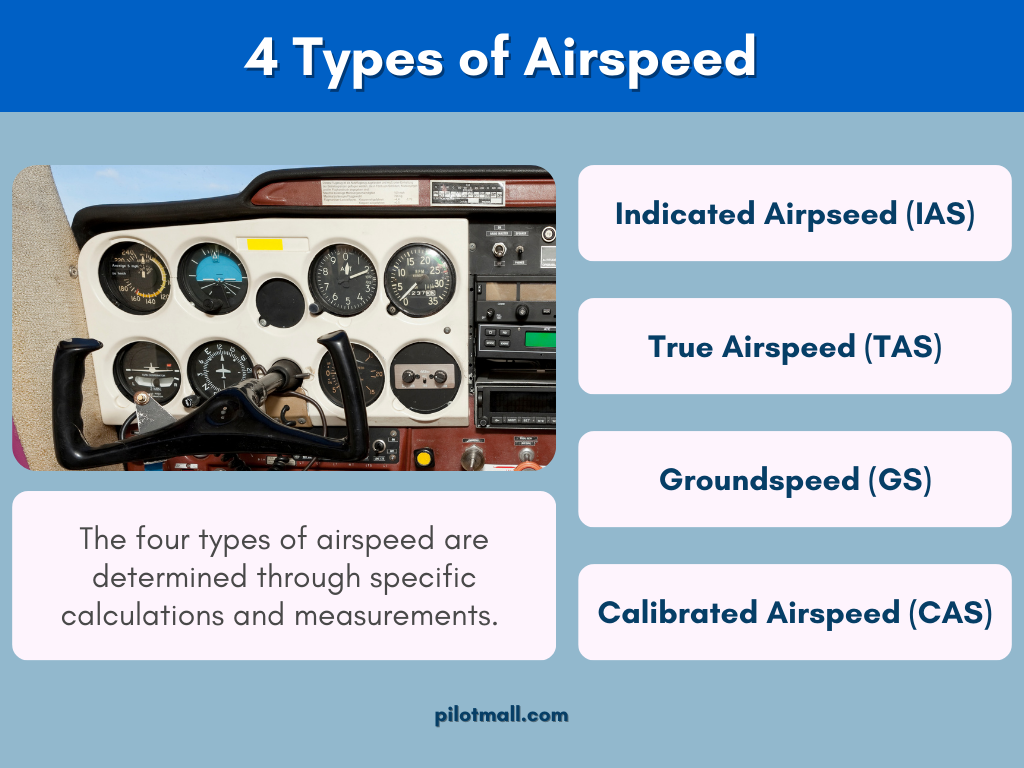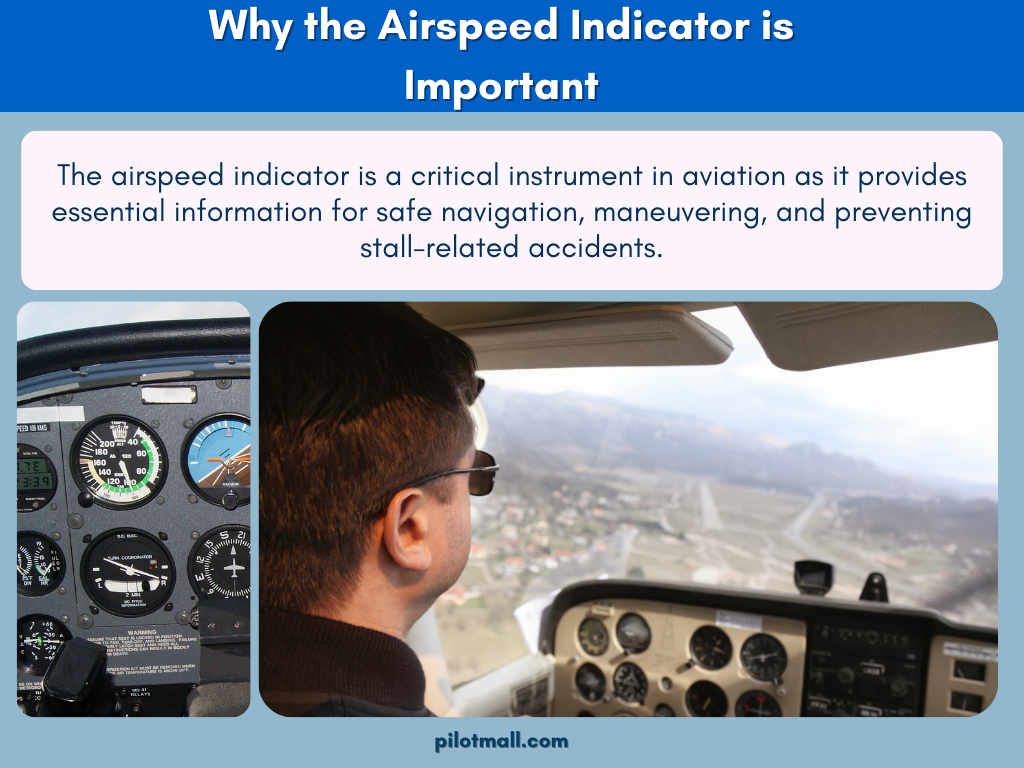Are you ready to take command of your plane? Whether it's a car or an aircraft, there is one critical piece of information you need to be aware of at all times—your speed. For cars, the answer lies in the speedometer, but for planes, the information comes from the airspeed indicator.
In this article, we will look at the fundamentals behind this device and why it plays such a crucial role in flight planning.
Ready? Let's get started!

What is the airspeed indicator?
The airspeed indicator is an instrument that displays the measured speed at which an aircraft is moving through the air. This indicator is one of three cockpit instruments that are part of the pitot-static system. The airspeed indicator is an FAA required instrument used primarily to provide guidance during climbs, descents, and landings.
Which type of airspeed does the airspeed indicator measure?
Unlike driving a car where all you need is a single speedometer to know how fast you are going, factors like wind, air density, and known instrument errors make measuring airspeed a little more complicated.
When flying, aircraft have certain speeds that are essential for safe operations. These are known as V-speeds. Pilots can take these speeds and reference 4 types of airspeed depending on what airspeed information they need to know.
Airspeed Types
The airspeed indicator displays the indicated airspeed (IAS). The indicated airspeed is the measured reading before any adjustments for known errors have been made. This reading is then adjusted for pressure and temperature variables to provide true airspeed (TAS). Pilots use both of these airspeeds to monitor aircraft performance.
Indicated airspeed is also the basis for calibrated airspeed (CAS) which is calculated by correcting the IAS for known position or instrumentation errors.
Groundspeed (GS) is calculated by taking true airspeed (TAS) and adjusting for wind. Thus, we can see that the indicated airspeed displayed by the airspeed indicator is vital for calculating all 4 types of airspeed.
(source: FAA PHAK )
What are the components of an airspeed indicator?
An airspeed indicator is made of seven main components that work together to collect air, compare air pressure, and generate an airspeed reading that the pilot can use.
The components of an airspeed indicator are:
Static Port
Static ports are air inlets mounted flush to the side of the aircraft in an area of minimally disturbed airflow. They take in air that is at ambient air pressure.
Static Line
The static line is the tube that runs from the static pressure port to the case of the airspeed indicator. If an aircraft has more than one static port it will have a static line running from each port.
Pitot Tube
A pitot tube is an L-shaped metal tube that opens into the relative wind and collects air to measure the ram air pressure generated by your plane’s motion. Air comes in through the pitot tube and flows into the pitot line.
Pitot Line
A pitot line is part of the pitot system, it connects the pitot tube to the airspeed indicator case. Ram air travels from the pitot tube through this line and into the pressure diaphragm that is housed inside the case.
Case
The case is the housing of the airspeed indicator. The case contains the pressure diaphragm and is connected to the static port via the static line. The case is not directly connected to the pitot line.
Pressure Diaphragm
The pressure diaphragm is an expandable container found inside the instrument case and attached to the pitot line. The diaphragm also connects to the needle in the instrument face through several rods and gears.
Instrument Face
The instrument face is the portion of the instrument that the pilot can see from the cockpit. A needle on the face displays the aircraft velocity in knots and is connected to the pressure diaphragm via levers and gears.
How does the airspeed indicator work?
The airspeed indicator operates based on air pressure differential. It receives air from both the static port and the pitot tube. This is different from the altimeter and vertical speed indicator instruments that are connected only to the static ports.
The airspeed indicator reflects the difference between the ambient static pressure coming in through the static port and the total pressure of the ram air from the pitot tube.
The static port is positioned on the side of the fuselage, parallel to the air stream. It collects static air that is at the ambient atmospheric pressure. The pitot tube is usually on the wing and is set perpendicular to the air stream.
This allows it to capture the total air pressure generated by the aircraft as it moves through the air. The static air is routed through the static lines and into the instrument case while the ram air from the pitot tube travels through the pitot lines and into the pressure diaphragm.
The static line air contains only static pressure while the ram air value includes both static and dynamic pressure.
The static pressure values offset, so the difference between the pressure of air coming through the static line and that coming through the pitot line indicates the dynamic pressure.
The diaphragm is flexible and expands or contracts based on whether the pressure it is receiving from the pitot line is higher or lower than the pressure the case is receiving from the static line.
The total pressure within the instrument case must remain constant, so pressure increases in the diaphragm while decreasing in the case and it decreases in the diaphragm when it increases in the case. The diaphragm experiences increased pressure at faster airspeeds and decreased pressure at lower airspeeds.
The dynamic pressure is compared to a calibrated known constant and translated into airspeed that is displayed on the instrument face as knots of indicated air speed. The needle on the instrument face is operated by gears and levers attached to the diaphragm.
What can cause airspeed indicator errors or malfunctions?
Pitot-Static Blockage
One of the most common reasons for an error or malfunction of the pitot-static system is a blockage of one or more of the static vents. Static vents can be blocked by debris like ice making it impossible to get airflow.
To help alleviate this problem, aircraft can have multiple static vents in different locations so that even if one is blocked, the instruments can receive outside air through another vent.
It is worth noting that depending on aircraft configuration and vent locations, the pressure from the alternate vent may be a less accurate representation of the true ambient pressure.
If your plane has only one vent and it is blocked or if you have multiple vents, but they are all blocked, the pressure inside the airspeed indicator will remain as it was when the blockage occurred.
If you descend, your indicated airspeed will read higher than it should. When climbing with a blocked static vent, your indicated airspeed will inaccurately decrease.
Pitot Tube Blockage
The pitot tube that takes in ram air can also get clogged with ice, dirt, insects, or other debris. Therefore it is kept protected with a pitot tube cover prior to flight. If your pitot tube is blocked on the ground and you miss it during your preflight check, you will quickly realize there is a problem as you pick up speed but the airspeed indicator continues to read 0 knots.
More often, a pitot tube blockage occurs in the air. When this happens, the pitot pressure will stay constant at the last collected pressure.
If only the pitot tube is blocked but the static vent is still open, you will see the indicated airspeed increase when you climb and decrease when you descend regardless of what is actually happening with your true airspeed.
Ice Blockages
Since ice blockages of pitot tubes are a known issue, some aircraft are outfitted with a pitot heater. If your plane has a heater, remember to use it, especially when flying IFR in winter conditions.
Limitations and Errors
The airspeed indicator provides pilots with useful information, but it is not without its known limitations and inherent errors.
The pressure change within the instrument is not instantaneous and has about a six to nine second delay, so you should never assume that an airspeed indicator is displaying your current, real-time airspeed. Instead treat it as advising you of your airspeed trend.
Another source of an instrument error is that calibrations are done for standard sea level. This means that the higher you go and the faster you travel, the more errors you will get. The air will be denser due to compression, and this can incorrectly indicate a higher than actual airspeed.
To help ensure that the airspeed indicator and other pitot-static system instruments are working correctly, the FAA mandates a system check every 24 months and after conducting maintenance that will impact the system.
The test can be completed by the manufacturer, a certified repair station, or a certified mechanic with a rating for your airframe, also, they can check and see if there was an installation error.
Why is the Airspeed Indicator is so important?
The airspeed indicator is a critical instrument in aviation as it provides essential information for safe navigation, maneuvering, and preventing stall-related accidents.
This instrument constantly displays the aircraft's current airspeed, allowing pilots to maintain proper speed during takeoff, cruise, and landing phases.
It aids in calculating necessary adjustments for climb, descent, or banking maneuvers, ensuring the aircraft operates within its safe envelope.
Most importantly, the airspeed indicator helps pilots monitor their proximity to the stall speed, the minimum airspeed required to maintain lift, thus preventing dangerous stalls that can lead to loss of control and potential crashes.
The airspeed indicator serves as a pivotal reference point for pilots to maintain precise control, avoid critical flight conditions, and ensure the safety of the aircraft and its passengers.
Takeaways
The airspeed indicator is a pitot-static system instrument that provides pilots with indicated airspeed readings to use during ascents, descents, and landings. The indicator gets its data through air pressure readings collected by the pitot tube and static ports.
It is important to ensure that the tube and ports remain free and clear of ice or other debris so that they provide accurate readings. An FAA-mandated system inspection every 24 months also helps to ensure the pitot-static instruments are fully functional.
Want to learn more about Airspeed?
Check out our articles related to Airspeed!
- Pitot-Static System: How does it work?
- The 4 Types of Airspeed: How Each Works (Complete Guide)
- How to Calculate True Airspeed and What It Is (Guide)
- Aircraft Vertical Speed Indicator (VSI): How Does it Work?
- Watch Your Attitude: A Complete Guide to Aircraft Attitude Indicators
- Constant Speed Propeller: How Does it Work? (Basics)
Read more about Airspeed Indicators and other flight training topics in our Flight Training Material: Private Pilot collection.

|
Rod Machado's Private Pilot/Commercial HandbookLearn to fly from a book that has personality with Rod Machado’s "Private Pilot/Commercial Pilot Handbook." In addition to having everything you need to know to become a knowledgeable and competent pilot, this book is full of wit, humor, analogies, and fun. |
Did you find this article helpful?
Do you think we missed anything important? Let us know in the comments below!













